Change Management –
Definition & Process

Change management involves breaking old patterns to make room for new ones. But how does this process work? What methods and tools are available to change managers, what stages do organizations go through in the change process, and what exactly is the difference between change management and organizational development? We show what types of change there are, how organizations can manage change, and why managers are increasingly responsible for “unlearning” the old to make room for the new.
Content
- What is change management?
- Why change management is so important
- Change management & organizational development
- Lean change management
- What change management models are there?
- How does change management work?
- Change management – the process
- Change management – the phases
- The phases of change
- Change management with Wonderwerk
- Transformation through innovation
- Why Wonderwerk?
What is change management?
By definition, change management refers to the active management of change. This process takes place within a limited time frame and involves moving an organization from an initial state X to a clearly defined target state Y. The ultimate goal is to achieve sustainable change that is put into practice.
In order for the target state to become the new norm, it is important to strategically plan, manage, control, and stabilize the individual steps in advance. To this end, we have various methods, tools, and concepts at our disposal in change management.
Change management helps companies and organizations to
- create awareness of the need for change at all levels.
- anticipate negative reactions and respond appropriately.
- give employees a clear picture of the target state and the path to get there.
- absorb any uncertainties that arise.
Why change management is so important
Change has always been important. But while “change” ten or fifteen years ago meant time-bound leaps in innovation, today continuous structural adaptation is the basic prerequisite for companies and organizations of all sizes to remain operational and competitive. Only organizations that are able to respond flexibly to the constantly changing conditions of our modern working world can survive. The reason for this can be summed up in one word:
SCARCITY.
Efficient management in times of change
Companies go bankrupt, merge with other companies or lay off a large part of their workforce. Elsewhere, old structures are being dusted off and organizational charts thrown out. These upheavals are not evidence of an economy or administration incapable of acting, but rather the result of (economic) existence under enormous pressure. Companies and organizations in the public and/or social sector today have less
- Time: Technological progress is exponential. Companies that are at the cutting edge today may be obsolete tomorrow.
- Resources: Raw materials are becoming more expensive and harder to obtain. At the same time, political and social demands for sustainability management are growing.
- Scope for action: Stricter legal requirements tie up resources and can hamper growth (e.g., when certain certifications become mandatory).
- Security: More and more providers are competing for orders in a globalized market.
At the same time, companies must respond to their employees’ demands for a better work-life balance (see our Cornerstone on New Work) and create prospects to remain attractive as employers. Only leadership that sees change as an opportunity and transformation as a driving force can turn these challenges into successes.
For this reason, change management often goes hand in hand with new approaches to leadership (see New Leadership) and is an indispensable component of successful innovation management.
Starting points for change management
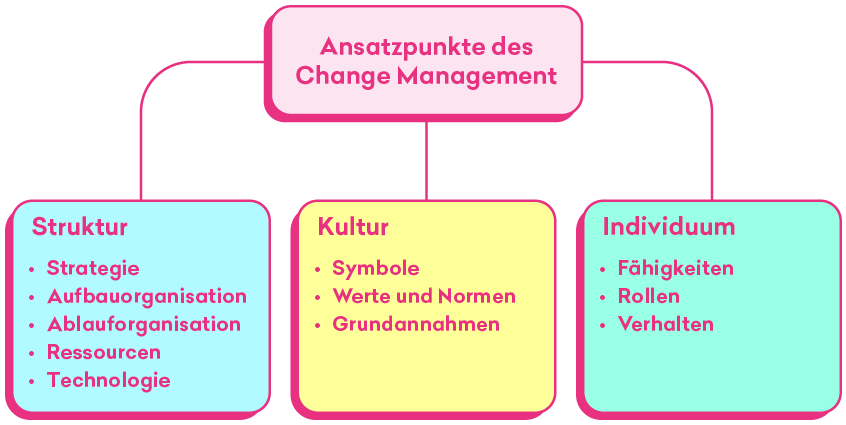
Change Management & Organisationsentwicklung
Change management has its origins in the theory of organizational development, which emerged in the United States in the 1930s. The pioneering theory of the “phases of change” goes back to Kurt Lewin.
In summary, the theory of organizational development states that increases in efficiency are achieved less through changes in working conditions and more through a stronger focus on employees.
Organizational development is therefore not aimed at a specific goal, but is a holistic, long-term approach. The aim is to optimize internal processes and structures in such a way that the economic goals of the company/organization are in harmony with the personal goals and development opportunities of the employees. Organizational development processes differ from change processes in that
- the specific change is integrated into long-term development processes.
- Employees play a key role in implementing the change.
- The goal of the change is not imposed “from above,” but is developed with the involvement of employees and adjusted as necessary.
- Employees are generally intrinsically motivated because the change is not imposed on them “from outside.”
Organizational development vs. change management
While organizational development involves the continuous adaptation and optimization of internal structures, change management involves supporting change processes that are time-limited and geared toward a specific end goal.
This goal is usually “set from above” because in many cases it arises from an economic or political necessity. Typical examples of necessary changes imposed from above include mergers between companies, the digitization of business processes, or the reorganization of departments.
| Change management | organizational development |
| Change processes that are limited in time and geared toward a specific target state. | Changes integrated into long-term development processes that do not usually pursue a fixed goal. |
| The goal of the change is normally specified “from above” because it arises from a specific need. | The goals are not predetermined but are developed with the participation of everyone in the company/organization. |
| Negative reactions such as fears and uncertainty are anticipated from the outset and those affected are supported accordingly. | Employees react predominantly positively to change because they are intrinsically motivated. |
| Change processes are often initiated, planned, and supported by consultants. | Consulting services for organizational development are available but not always necessary. |
Organizational development and agility
Involving employees in the development of the organization requires a flexible management framework. This is why more and more organizations are choosing to create the appropriate structures as part of an agile transformation and, in the process, are also introducing OKRs (Objectives and Key Results), for example. OKR breaks down the rigid top-down management approach and replaces it with a flexible bottom-up principle.
Lean change management
Classic change management and agility merge in what is known as Lean Change Management (LMC). This change management method aims to implement changes particularly quickly using the iterative approach from agility: By dividing large changes in companies and organizations into as many small steps as possible, the following advantages arise:
- Quick wins: Small goals are easier (and faster) to achieve than large ones. In lean change management, we therefore see initial successes very quickly.
- Easier correction: Continuous implementation and ongoing feedback ensure that errors are identified very early on and corrections can be implemented quickly.
- Stronger identification: By implementing a large number of small sub-projects in parallel rather than ONE large project, everyone is involved in the change process in LCM, which increases acceptance and creates a shared vision of the target state.
A good example of the lean change management approach would be the transition to a new working method, for example in the context of a transformation toward New Work.
Instead of introducing changes directly at all levels, the company starts with a small group of employees. This “test group” tries out new working methods and provides ongoing feedback, which is used to make improvements. By gradually involving more employees in the process and continuously improving it, acceptance of the change among the workforce increases. At the same time, conflicts can be identified early on and resolved.
What change management models are there?
Before we look at how change management works in practice, let’s take a quick look at the different models that have developed around the topic of change management. The best-known models are Kurt Lewin’s 3-phase model, John P. Kotter’s 8-step model, and Elisabeth Kübler-Ross’s change curve. All of these models focus on how teams and companies implement change, cope with it emotionally, and accept it as the new normal.
3-phase model according to Lewin
Lewin’s change management model dates back to the 1940s. It is considered a pioneering theory of organizational development, but is still used today to describe change processes. Lewin describes the behavioral changes in employees that accompany change using the example of an ice cube that goes through three phases before being reshaped: (1) unfreezing, (2) moving, and (3) refreezing.
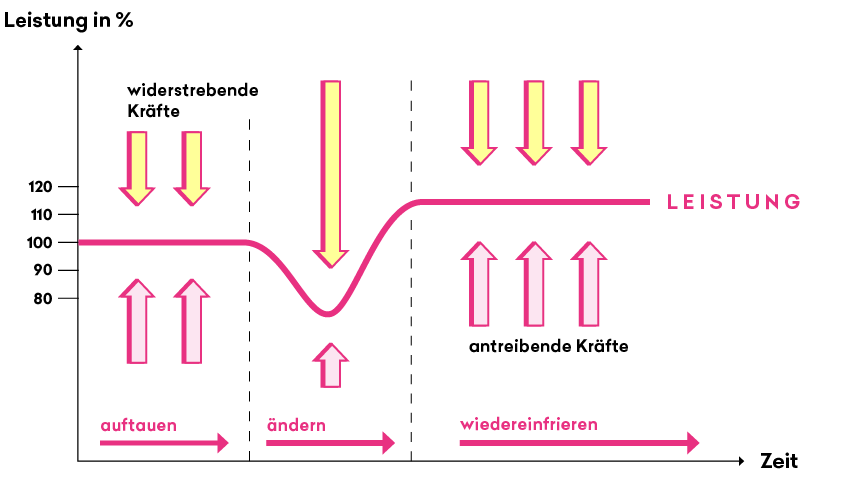
Kotter’s 8-step model
In his 8-step model, John P. Kotter focuses primarily on the people who are undergoing the change. He explores how change must take place in order to reduce resistance among managers and employees and build trust in the process.
The eight steps of Kotter’s model describe the individual steps or stages of the change process: from recognizing that change must take place, to involving everyone affected, to jointly implementing and stabilizing the change.
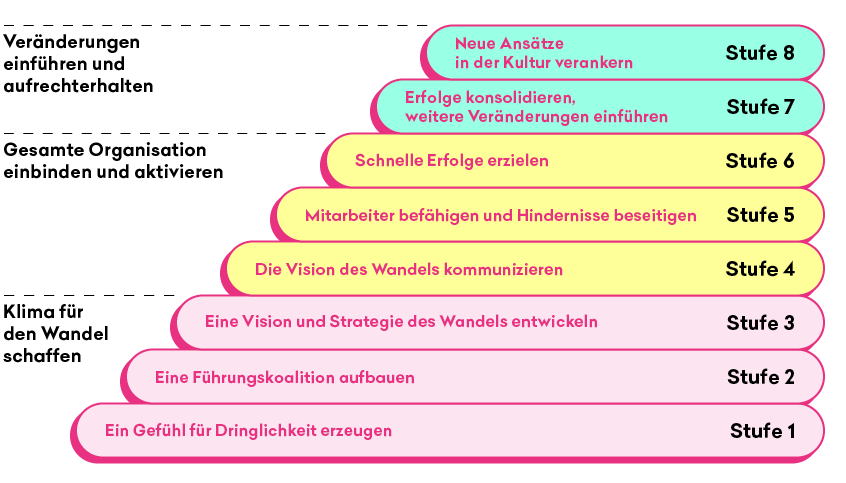
The change curve according to Kübler-Ross
Elisabeth Kübler-Ross is a well-known death researcher who developed the “5 stages of grief.” In fact, these five stages can also be reliably applied to change processes, as the model generally describes how people process change. By addressing the five stages (1. denial, 2. anger, 3. bargaining/negotiation, 4. depression, 5. emotional acceptance), organizations can better anticipate the reactions of their employees and respond appropriately.
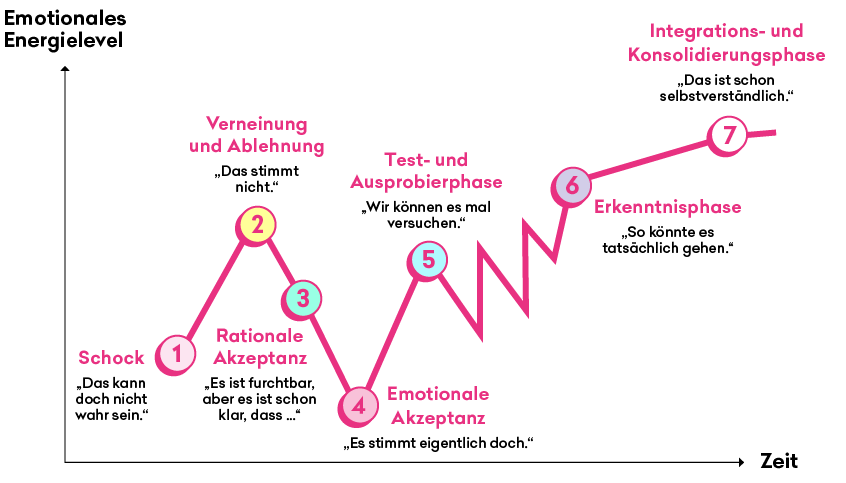
How does change management work?

Change management encompasses all activities, tasks, and measures necessary to bring about comprehensive and far-reaching change in an organization. Successful change processes often involve external consultants who not only have the necessary knowledge of change management, but also the required process expertise.
Whether new processes, structures, and/or strategies are actually implemented in a sustainable manner depends largely on how well this process is prepared and implemented:
The main task of change management is to plan, control, and monitor the respective individual steps in a strategically sensible manner before moving on to the stabilization phase. During the adjustment process, it is also the responsibility of those in charge to intervene in a targeted manner whenever the process stalls and/or threatens to exceed the time frame.
Change management – the process
From initial awareness of the problem to stabilization of the target state: Change processes are usually marked by a beginning and an end, have a specific goal, and can be divided into individual phases. Various methods and tools are used to implement the individual steps.
Awareness of shortcomings
Change usually arises from a shortcoming. Economic change processes also usually have a trigger, a reason for dissatisfaction with the status quo. This could be declining sales, reduced competitiveness, or dissatisfied employees.
Methods/tools that create this awareness of the problem often include competitor analysis, market research, or surveys within the organization. It is important to create a sense of urgency: Things cannot go on like this, we have to change something!
Problem analysis
Once you are aware of the problem, it is time to analyze it: What exactly are the problems and where do they arise? Are these problems something we can solve ourselves, or do we need an “outside perspective”? Methods/tools that are helpful in the analysis phase include process analysis and organizational analysis.
Formulation of the objective(s)
Once we know how and where the problems arise, we can formulate a target state. As this is one of the most critical phases in the change process, organizations should seek external support at this stage.
Change management specialists use various techniques to arrive at a meaningful target formulation. Among other things, this involves optimizing communication. Methods/tools used in this context include moderated conferences, strategy workshops, and conflict mediation.
Concept
Once the goals have been formulated, the concept follows: How exactly do we achieve our goal? What individual steps are necessary? What time frame are we talking about, what budget do we have available, who will play an important role in the change process (stakeholders)?
The methods/tools used here depend on the objectives and include moderated workshops, team and individual coaching, stakeholder analysis, and consulting on process optimization and project management.
Control
The change management process is only complete once the results have been evaluated: Was the goal achieved? Were there any setbacks? If so, what were the reasons for this?
Tools/methods available to measure the results include interviews with stakeholders and employee surveys. Often, a so-called evaluation catalog is created in advance, which is used as a basis for analyzing the results.
Change management – the phases
In Bezug auf Veränderungsmanagement ist immer wieder von den „Phasen“ im Change-Prozess die Rede. Diese Phasen beschreiben nicht die strategischen Einzelschritte wie Problemanalyse oder Zielformulierung, sondern sie bilden die emotionale Resonanz der Mitarbeiterinnen und Mitarbeiter ab.
Mitarbeiterführung im Veränderungsmanagement
Da große Veränderungen in vielen Organisationen auch Umwälzungen auf personeller Ebene mit sich bringen, ist der Umgang mit negativen Reaktionen ein wichtiger Teil des Change Managements. Werden Ängste, Unsicherheiten und andere negative Gefühle nicht von Anfang an gut gemanaged, ist der Wandel im Zweifel schon wieder vorbei, bevor er richtig angefangen hat: Für einen erfolgreichen Change-Prozess müssen die Mitarbeiterinnen und Mitarbeiter „on board“ sein.
Führungskräfte sind in Change-Prozessen also doppelt gefordert.
Zum einen ist eine aktive Führung mit Hands-on-Mentalität im konkreten Veränderungsprozess essenziell: Ohne starke Führung, die offen kommuniziert, keine Informationen zurückhält und ein offenes Ohr für Ängste und Kritik hat, können Change-Prozesse schnell ins Stocken geraten.
Zum anderen müssen Führungskräfte, um notwendige Veränderungsprozesse begleiten und aktiv vorantreiben zu können, auch zunehmend Dinge „verlernen“:
Im Kontext von New Work und Digital Leadership sind sie gefordert, „Führung“ neu zu denken, sich mit agilen Arbeitsmethoden auseinanderzusetzen, Trends zu erkennen und innovativ mit Herausforderungen umzugehen.
Die Phasen der Veränderung
Im Change Management arbeiten wir mit unterschiedlichen Modellen, um die Phasen, welche die Mitarbeiterinnen und Mitarbeiter durchlaufen, abzubilden. Die bekanntesten Modelle sind das sehr reduzierte 3-Phasen-Modell von Lewin und das sehr detaillierte 8-Stufen-Modell von Kotter (siehe oben). Wir bedienen uns im Folgenden eines vereinfachten 5-Phasen-Modells.

Ablehnung und Verleugnung
Das darf nicht wahr sein!
In vielen Organisationen folgt auf die Ankündigung vor allem eines: Schock. Gerüchte kursieren, Befürchtungen werden laut und manche schmieden sogar schon Ausstiegspläne. Die Wenigsten sind dem Prozess gegenüber aufgeschlossen.
„Gut führen“ bedeutet in dieser Situation: Keine Informationen zurückhalten, Möglichkeiten zum Austausch schaffen und Verständnis zeigen. Gleichzeitig ist es aber wichtig, die Botschaft nicht zu verwässern: Die Veränderung wird kommen.

Widerstand und Verhandlung
Ich mache da nicht mit!
Auf den Schock folgt das Gegenrudern. Der Widerstand kann von Verhandlungsversuchen („Das ist nicht zielführend.“) bis hin zu offener Arbeitsverweigerung, Kündigungsdrohungen und ausgesprochenen Kündigungen gehen.
Jetzt ist es wichtig, die Kritik der Mitarbeiter:innen nicht zu ignorieren. Führungskräfte sollten sich erkundigen, was genau hinter der Ablehnung steht (z.B. Angst vor Statusverlust), und durchaus auch Gegenvorschläge diskutieren. Die Androhung von Konsequenzen sollte immer das letzte Mittel sein.

Trauer und Depression
Das ist einfach nur schrecklich!
Bleibt die Führung ihrer Linie treu, folgt auf die Verweigerung die Erkenntnis, dass der Wandel kommen wird. Für die Mitarbeiter:innen bedeutet diese Erkenntnis häufig einen Verlust, der betrauert werden muss. Wir sprechen in diesem Zusammenhang auch oft vom Tal der Tränen.
Organisationen sollten in dieser Phase Möglichkeiten zum Austausch schaffen und idealerweise auch professionelle Begleitung anbieten, z.B. durch Supervision und Gruppen- oder Einzelcoaching. Wichtig ist, dass die Mitarbeiterinnen und Mitarbeiter mit ihren Gefühlen der Wut und der Trauer nicht alleine gelassen werden.
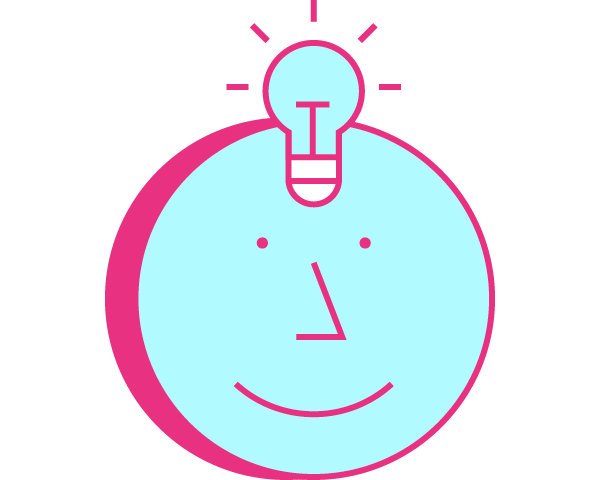
Ausprobieren und Entdecken
Vielleicht ist es doch nicht sooo schlecht …
Auf die Trauer folgt die rationale Einsicht, dass die Veränderung nicht aufzuhalten ist. Die meisten Mitarbeiterinnen und Mitarbeiter werden an diesem Punkt zwar noch um das Alter trauern, aber sie strecken ihre Fühler auch vorsichtig Richtung Zukunft: Was bedeutet diese Veränderung für mich? Wo ist mein Platz in der neuen Struktur?
In dieser Zeit der Unsicherheit gibt eine gute Führung Halt und weist die Richtung. Jetzt gilt es, aufgeschlossen zu bleiben, Chancen und Perspektiven aufzuzeigen, (Teil)erfolge zu kommunizieren und Leistungen zu würdigen. Kurzfristige Erfolge sind ein guter Weg, um Mitarbeiter:innen “bei der Stange” zu halten.

Akzeptanz und Commitment
Ich kann es ja mal versuchen.
Nachdem das Alte angemessen betrauert wurde, entsteht Raum für das Neue: Die (meisten) Mitarbeiterinnen und Mitarbeiter können sich jetzt mit der Veränderung arrangieren und sind bereit, Neues zu lernen und umzusetzen: Sie geben dem Wandel eine Chance.
Für die Führung ist JETZT der Moment gekommen, die individuellen Leistungsziele dem Zielzustand des Unternehmens anzupassen. Gleichzeitig ist es wichtig, den Mitarbeiter:innen ihr Entwicklungspotenzial in den neuen Strukturen aufzuzeigen, Förderungen zu ermöglichen und Leistungen zu würdigen.
Change Management mit Wonderwerk

Wonderwerk Consulting begleitet seit Jahren sehr erfolgreich Change-Prozesse. Wir liefern den notwendigen Blick von außen und sind Spezialisten für den Prozess hinter dem Wandel: Wir wissen nicht nur theoretisch, wie Change funktioniert, sondern kennen sämtliche praktische Hürden, die einer nachhaltigen Veränderung in den meisten Organisationen im Wege stehen.
Damit wir Sie erfolgreich durch den Wandel begleiten können, möchten wir zunächst verstehen, wie Ihr Unternehmen aktuell funktioniert und vor welchen Herausforderungen Sie stehen.
Auf Basis dieser Voraussetzungen formulieren wir mit Ihnen gemeinsam Ihren neuen Zielzustand, entwickeln ein Konzept und planen die Umsetzung sowohl strategisch als auch zeitlich und budgetär. Wir unterstützen Sie dabei,
- Ihre Ziele realistisch und konkret zu formulieren.
- Ihren Zielzustand schneller und reibungsloser zu erreichen.
- die für den Wandel wichtigen Personen (Stakeholder) zu identifizieren und sie als Unterstützung zu gewinnen.
- alle Arten von Reaktionen zu antizipieren und angemessen darauf zu reagieren.
- Ihre Kommunikation in Bezug auf Zielsetzung und Maßnahmen zu optimieren, um schneller Erfolge zu sehen.
- Ihre Energie auf die richtigen Maßnahmen zu konzentrieren.
- den Zielzustand zu stabilisieren.
Transformation durch Innovation
In vielen Unternehmen ist zwar der Mangel spürbar, aber es ist keine Lösung in Sicht: Sie wissen, dass sich die Ansprüche Ihrer Kundinnen und Kunden bzw. der Nutzerinnen und Nutzer Ihrer Produkte verändert haben, aber Sie wissen nicht, wie Sie den Forderungen nachkommen sollen: Immerhin sind die Ressourcen ja die gleichen geblieben oder nehmen sogar ab. Als Profis für Innovationsmanagement und Future(s) Thinking unterstützen wir Sie gerne dabei, neue Wege zu gehen. Dabei liegt unser Fokus stets auf den Menschen, die Ihr Unternehmen gestalten: Unter unserer Anleitung werden Ihre Mitarbeiter:innen zur Quelle neuer Ideen und Konzepte (mehr zu unserem Angebot).
Warum Wonderwerk?
Weil wir über den Prozess hinausdenken. Die Arbeit unserer Consultants endet nicht, wenn die Veränderung umgesetzt ist. Erst, wenn der neue Zustand in Ihrer Organisation zur Norm geworden ist, haben auch wir unser Ziel erreicht.
Kontakt
Anna-Maria Hausdorf
anna-maria.hausdorf@wonderwerk.com
Buchen Sie jetzt einen unverbindlichen Beratungstermin!
Unsere Change Management Trainings

Neues Arbeiten

New Leadership

Agile Methoden

Trendmanagement







